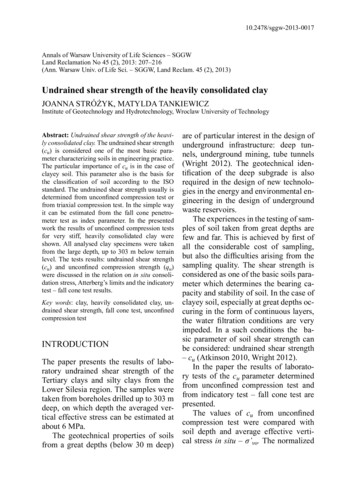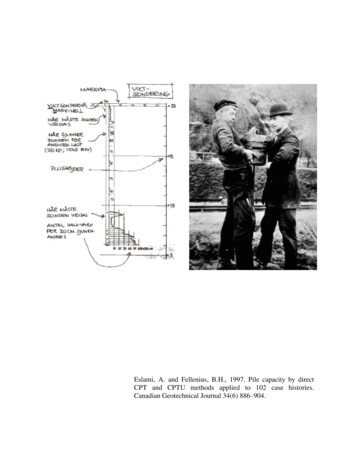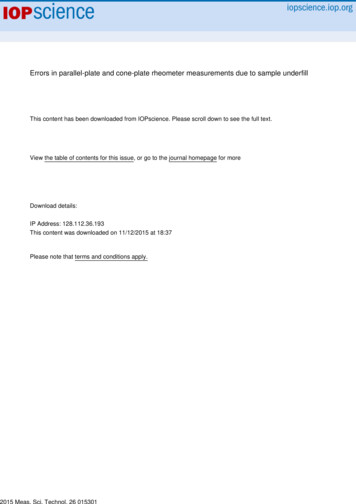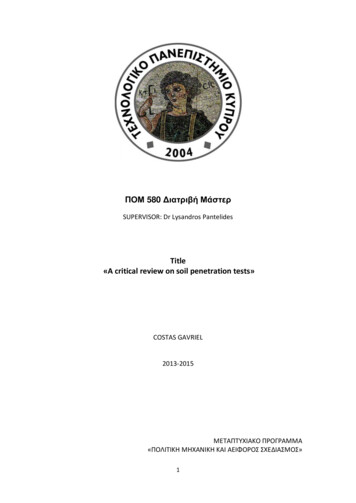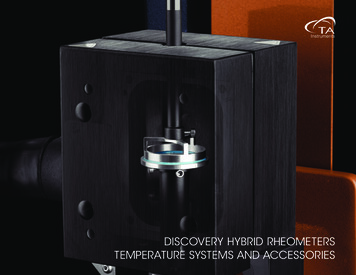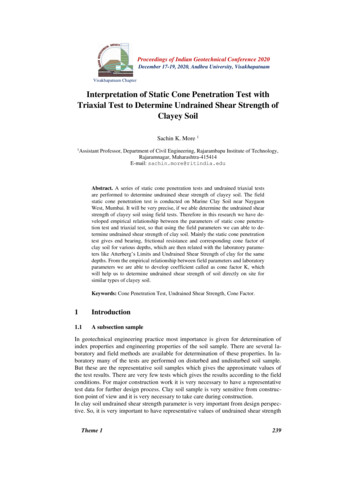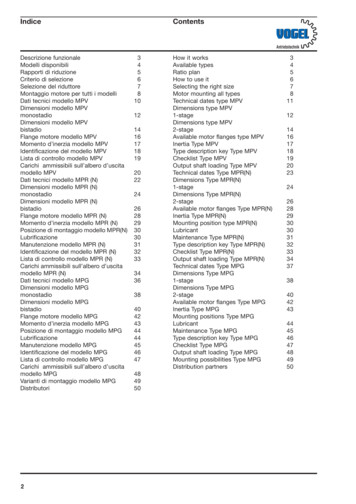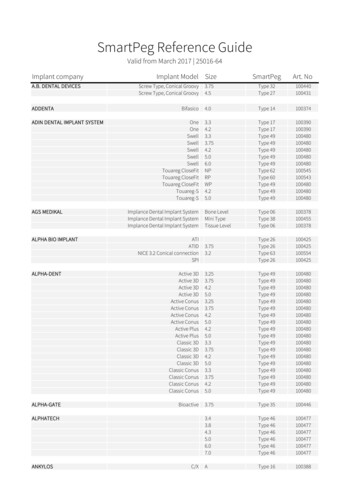
Transcription
Cone Penetration Testing 2018 – Hicks, Pisanò & Peuchen (Eds) 2018 Delft University of Technology, The Netherlands, ISBN 978-1-138-58449-5Effect of cone penetrometer type on CPTU results at a soft claytest site in NorwayT. Lunne, S. Strandvik, K. Kåsin & J.S. L’HeureuxNorwegian Geotechnical Institute, NGI, Oslo, NorwayE. Haugen, E. Uruci, A. Veldhuijzen, M. Carlson & M. KassnerNorwegian Public Road Administration, NPRA, Oslo; Pagani, ItalyGeomil, The NetherlandsGeotech, SwedenAdam Mickiewicz University in Poznan, PolandABSTRACT: Seven different cone penetrometers from 5 manufacturers have been used in a comparativetesting program at the Norwegian GeoTest Site (NGTS) on soft clay in Onsøy, Norway. Tests with all conetypes give very repeatable penetration pore pressure, u2. When comparing tests with different cone types,six of the cones give very similar u2 values. One cone type give consistently higher u2 values. Measuredcone resistance, qc, generally varies somewhat more, both regarding tests with the same cone, and whencomparing results of one cone type with another. Some of the cone types give good repeatability for sleevefriction, fs, readings, while some show relatively large variation. When comparing fs from different conetypes the variation is quite large, which is in line with previous experience. An attempt has been made tounderstand the reasons for the large fs variations.1INTRODUCTIONIt is a well-known fact that even if cone penetrometers adhere to the international standards (e.g.ISO 22476–1:2012), results of tests using equipment from different manufacturers can give different results (e.g. Lunne et al.1986, Gauer et al. 2002,Powell & Lunne 2005, Tigglemann & Beukema2008, Lunne 2010, Cabal & Robertson 2014). Thisis particularly a problem when soil investigationcontractors using different cones operate in thesame area, and especially on the same project.Lunne et al. (1986) carried out a comprehensivelaboratory and field study comparing tests resultsfrom cone penetrometers from 8 different manufacturers. In that study it was shown that all threeparameters qc, fs and u2 could vary significantly,depending on the equipment used.A later study by NGI (Gauer et al. 2002) basedon a number of different cone penetrometerstested in Onsøy clay showed that the situation hadimproved. The cone resistance showed relativelysmall scatter, and the penetration pore pressurewas even more repeatable from one cone type toanother. However, the scatter in the measuredsleeve friction, and hence the friction ratio, wasvery significant.Powell & Lunne (2005) showed that if calibration of all cone penetrometers used was done in aconsistent manner by one organization who alsocarried out all tests, then the variation in resultswill be reduced.Over the last few years further improvementsin cone design and electronics have occurred bysome cone manufactures. The establishment of5 new national test sites in Norway (L’Heureuxet al. 2017) has given the opportunity to revisit theproblem of uncertainties in CPTU test results byinviting several companies to do testing at 4 of thesites.This paper includes only results of tests fromthe soft clay site at Onsøy, a later paper will includetest results from all 4 test sites.For the tests reported herein the calibrationswere carried out by each cone manufacturer. It isthought that the test results will then be more representative for general practice in the soil investigation industry. Each cone manufacturer has triedto follow requirements and recommendations ininternational standards and guidelines.417
23ONSØY TEST SITEThe Onsøy test site is located about 100 km south ofOslo. It consists of a 25–35 m thick marine depositwhich has never been subjected to higher verticalstresses than today, but it has an over consolidatedratio due to ageing. The Onsøy test site has beenused by NGI for more than 40 years, including testing out of in situ tools and testing many types ofsamplers (Lunne et al. 2003). Due to developmentof the area for industrial purposes several locationsat Onsøy have been used over the years. The presentsite appears to be slightly less uniform compared tothe previous locations (L’Heureux et al. 2017). Asoil profile is shown in Figure 1.Figure 1.Table 1.DESCRIPTION OF CONEPENETROMETERS USEDSeven different cone penetrometers from five manufacturers were used in the present study. Some keydimensions and other information about the conepenetrometer is given in Table 1.As can be seen from Table 1 six of the cone penetrometers are of the compression type with bothcone resistance, qc, and sleeve friction, fs, beingmeasured by separate compression load cells. Oneof the cones is of the subtraction type where onecompression load cell measures qc, and anotherload cell measures qc fs. Then fs can be calculatedby subtraction.The penetration pore pressure is measured at thelocation just above the conical part, u2.The porepressure measurement systems vary as shown inTable 2 where the filter type and saturation fluidare summarized. Six of the cones use filter made ofbronze, brass or stainless steel. Five of these use silicon oil as saturation fluid and one uses glycerin. Oneof the cone penetrometers use a so-called slot filter.As described in ISO 22476–1:2012, in this systemthe pore pressure is measured by an open systemwith a 0.3 mm slot immediately behind the conical part. The slot communicates with the pressurechamber through several channels. De-aired water,antifreeze (glycol) or other liquids can be used tosaturate the pressure chamber, whereas the channelsare saturated with gelatin or a similar liquid.Soil profile at Onsøy.Dimensions and other relevant information regarding the cone penetrometer used in this apacityqc fs SubtrCompCompCompComp5025100100505075Table 2.1.60.5110.5112.5222222Pore pressure measurement systems for the various cone penetrometer used in this study.ConetypeFilter typeSaturation fluidDateperformedNumberof tests1234567BronzeBronzeBrass 38 micron (SIKA B-20)Brass 38 micron (SIKA B-20)Brass 38 micron (SIKA B-20)SlotStainless steel, S/S 10 micronSilicone ISOVG 100GlycerineSilicone oil 200 fluid 50 cStSilicone oil 200 fluid 50 cStSilicone oil 200 fluid 50 cStGrease/oilSilicone oil, DC200, 50 7141120174324432418
4TEST PROGRAM AND MEASUREDPARAMETERSThe tests included in this paper were carried outbetween 4th September and 17th November 2017within an area of 5 m by 12 m. All tests were carried out to a depth of 25 m below ground levelexcept for cone 1 which was stopped at 21 m. Porepressure measurements show that the water tablehas been at about 0.5 m throughout the testingperiod. Due to various circumstances a variousamount of soundings (2–4) were carried out witheach of the cone penetrometers. Predrilling to 1 or2 m was used for the tests with cones 2, 6 and 7.Figure 2 shows the results of all tests from theseven cone penetrometer types, in terms of measured qc, u2 and fs. The following immediate observations can be made from visual inspection:Figure 2. For all cone penetrometers except cone 3, u2show very good repeatability. The two profileswith cone 3 are deviating 10–60 kPa from eachother in the depth interval 5–20 m. The largedeviation between 21 and 25 m is possibly causedby the sounding being influenced by a neighborCPT hole. For all cones the measured qc exhibit reasonablygood repeatability, but not as good as u2 Most variations occur for fs; especially for cones1, 2, 3 and 7.All dimensions in mm; All areas mm2; Capacityqc, fs and u2 sensors in MPa; nominal means average values given by manufacturer, D1 diameterof cylindrical part of cone tip; D2 diameter ofsleeve; h height of cylindrical part of cone tip,L1 length of friction sleeve, Ac cross-sectionalMeasured qc, u2 and fs vs depth for all CPTU profiles included in study.419
area of cone tip, Asb area where pore water pressure can act at bottom of friction sleeve; Ast areawhere pore water pressure can act at top of frictionsleeve; As area of sleeve; a area ratio of cone;b are ratio of sleeve55.1COMPARISON BETWEEN THEDIFFERENT CONE TYPESMeasured parametersFor all types of cones used a representative profile has been chosen. Average values have beenworked out for all three basic measurements. Obvious erroneous results caused by poor saturation,like for cones 4 and 5 have been excluded as wellas some other anomalies. One test with cone 7 wasnot included due to large zero shift observed attest completion. As mentioned in the introduction,details in calibration of CPTU sensors can potentially vary between different cone manufacturers,especially in the lower range of values as in softclay. At 10 m for instance a u2 value of 300 kPais typically measured and the nominal capacity ofthe pore pressure sensor is 2000 kPa, this meansthat about 15% of the capacity is utilized. qc withcapacity of 100 MPa about 0.3% is typically utilized at same depth. And for fs with a typical loadcell capacity of 1 MPa about 0.8% is utilized. Itcan be expected that the u2 reading may be moreaccurate and consistent since a larger part of thecapacity of the measurement sensor is utilizedcompared to qc and even more so fs.In addition to the general calibration which isnormally carried out at room temperature sensitivity of zero readings to change in temperature canalso be important.Figure 3a compares the representative profilesof the measured parameters (qc, u2 and fs), withoutany corrections for the 7 cone types.It should be noted that the a-factor has beenmeasured in a calibration vessel for each coneused and may deviate slightly from the nominalvalues given in Table 1. The qc profiles in Figure 3for cones 1, 3 and 4 showed much lower valuesthan the other tests. The a values for these coneswere not much lower than the others so this effectcannot explain the differences in qc. Based on previous experience it was suspected that zero shiftcaused by different temperature at ground level(generally about 15 C, but in a few cases as lowas 0 C) and soil temperature (7 C) could occur.Laboratory calibration tests by two of the manufacturers (cones 1, 3, 4 and 5) showed that zeroshifts due to change in temperature from 15 to7 C could cause measured qc to be too low by50–100 kPa. For fs temperature zero shifts were1–4 kPa for the same cones. For u2 the temperature zero shifts were not significant. Cone 7 givesFigure 3. Comparison of representative values of qc, u2,fs, qt, Bq and Rf for all cones.higher qc, even though the two profiles carried outwith this cone gave very similar qc as shown inFigure 2. This can only partly be explained by anobserved zero shift, which is 21 kPa for the average profile for cone 7.For cones 1, 3, 4 and 5 corrections for temperature zero shifts have been made before computingthe derived parameters. For cone 2 zeroing beforetests was done in a bucket with temperature as inground. For cone 7 the air temperature was quiteclose to ground temperature, No corrections wererequired for the tests with these two cones.Except for cone 6, u2 shows remarkably goodcomparison among the cone types. Cone 6 isthe only cone using a slot (filter) instead of a filter. This may be an explanation why u2 is higher(20–80 kPa in depth interval 5–15 m) compared tothe other cones. However, neither NGI nor NPRA,who have many years of experience with using slotfilters have observed such deviations earlier.5.2Derived parametersDerived parameters qt, Rf and Fr are also shownin Figure 3b. The derived parameters are definedas follows:qt qc (1 a) u2; Rf fs/qt, %(1)Considering qt the range has narrowed downconsiderably when compared to the measured qcvalues. Computed Bq values are as expected for asoft clay and generally within a range of 0.65–0.80.420
The range for Rf is larger, indicating that for softclay Bq can be a more reliable classification parameter compared to Rf. Lunne & Andersen (2007)summarised the potential main reasons for lack ofaccuracy in fs:1. Pore pressure effects on ends of the sleeve.2. Tolerance in dimensions between the cone andthe sleeve.3. Surface roughness of the sleeve.4. Load cell design and calibration.Due to limited space, only factors 1 and 2 willbe discussed in the following. To correct sleevefriction for pore pressure effects it is necessary toknow the pore pressure in the u3 position (behindthe sleeve). Sleeve friction corrected for pore pressure effects:ft fs (u2 Asb u3 Ast)/As(2)NGI has previously carried out triple elementCPTU at Onsøy which showed that on averageu3 0.77 u2. This has been used here for calculating ft. Previous studies, e.g. Gauer et al. (2002) andPowell & Lunne (2005) have shown that the porepressure correction has resulted in lower variationin ft compared to fs.Figure 4 shows fs (corrected for temperaturezero shifts for the cone types mentioned above)and ft vs depth. For all cones except cone 6 thepore pressure correction is very small due to thefollowing facts: i) equal end areas at both end ofsleeves, ii) relatively small end areas and iii) u3 isquite small compared to u2. And when comparingfs with ft in Figure 4 the differences in the ranges forfs and ft are indeed small. For cone 6 the correctionis larger due to difference in end areas at the upperand lower ends of the friction sleeve. Estimates ofpore pressure effects do not explain the differencesin fs.The effect of variations in sleeve diameter andcone diameter have been demonstrated by Holtrigter & Thorp (2016) and Cabal & Robertson(2014). Holtrigter & Thorp (2016) showed that ifthe friction sleeve diameter is larger than the conediameter this can have a significant influence onfs, even if the sleeve diameter is within the tolerances given in the international standards (ASTM2012, ISO 2012). Figure 5 shows the results at theHuapai (clay) site. The cone diameter in Holtrigter& Thorp’s work was 35.7 mm and sleeve diameters ranged from 35.7 to 36.15 mm. Based on theresults shown in Figure 5 and results at 4 othersites, Holtrigter & Thorp suggested correction factors to take into account the effect of larger diameter of sleeve compared to cone. Assuming thatHoltrigter & Thorp’s correction factor for theirHuapai clay can also be used for Onsøy clay, andusing the diameters given in Table 1, the followingcorrections can be applied to the present fs values:cones 1 and 6: 1.0; cones 2, 3, 4 and 5: 0.9; cone7: 0.8.The overall range for the measured fs is 5.3 to9.4; applying the correction factors suggested byHoltrigter & Thorp for Huapai clay the rangereduces somewhat to 5.0 to 8.1.The above indicate that for the present testseries the variation in measured fs values can onlyto some limited extent be explained by the effectsof oversized friction sleeve diameter.Figure 4 shows that Rf varies as expected forone type of cone to another. At 10 m Rf variesFigure 5. Results of tests with different sleeve diametersHuapai clay from Holtrigter & Thorp (2016).Table 3.Average values at 10 m depth, kPa.Cone Cone Cone Cone Cone Cone Cone1234567Figure 4. Comparison of fs, ft, Rf and Fr for all cones. fsis corrected for temperature effects.fs mea. 6.8fs corr. 6.84219.08.17.16.45.65.09.38.45.35.39.47.5
from about 1.0 to 2.8%. If cone 6 is excluded thisreduces to 1.7 to 2.8%.5.3Final remarksThe above discussion indicate that equipmentrelated issues cannot explain all the variation inCPTU readings experiences in this study. A recentstudy by Kardan et al. (2016) showed that procedures and operator skill can have significant effectson the test results, in addition to the equipment.Thus uncertainties related to the test results canbe caused by both the equipment and proceduredetails as well as operator skill.In the present study, tests with cone types 3, 4and 5 were carried out by the same personnel usingone rig. Tests with all the other cone types werecarried out by different personnel and rigs. It cannot be excluded that this also has had an influenceon the results of tests with different cone types.The problems with the zero shifts caused by different air and ground temperature could have beenavoided if the zero readings at the start of the testshad been carried out with the cone in a bucket withthe same temperature as the ground. This procedure was followed for the tests with cone type 2.6SUMMARY AND CONCLUSIONSSeven different cone penetrometers from 5 manufacturers have been used in comparative testingprogram at the Norwegian GeoTest Site (NGTS)on soft clay at Onsøy, Norway. Two to four testswere carried out with each cone type and theresults have been systematically compared. Themain findings are:1. Tests with all cone types gave very repeatablepenetration pore pressure, u2. When comparingtests with different cone types, six of the conesgive very similar u2 values. One cone type usinga slot filter gave consistently higher u2 values.2. Measured cone resistance, qc, generally variessomewhat, regarding test with the same cone,and more when comparing one cone type withanother. This is expected since the cones havedifferent a-factors. Taking zero shifts for different air and ground temperatures into account,and correcting for pore pressure effects,improved significantly the comparison betweenthe qt values for the different cone types.3. Some of the cone types give good repeatabilityfor sleeve friction, fs, readings, while some showrelatively large variation. When comparing fsfrom different cone types the variation is quitelarge, which is in line with previous experience.An attempt has been made to understand thereasons for the large fs variations, but there arestill unanswered questions.ACKNOWLEDGEMENTSPagani, Geotech and Geomil contributed by performing the tests with their CPTU equipment.NPRA and NGI carried out the remaining testsusing other CPTU equipments. The authors wouldlike to acknowledge the Research Council of Norway (RCN) for funding the Norwegian GeoTestSite project (No. 245650/F50).REFERENCESASTM D5778–12. 2012. Standard Test Method for Performing Electronic Friction Cone and Piezocone Penetration Testing of Soils, ASTM International. www.astm.org.Cabal, K. & Robertson, P.K. 2014. Accuracy and Repeatability of CPT Sleeve Friction Measurements. Proc.CPT’14, Las Vegas, Nevada, USA.Gauer, P., Lunne, T., Mlynarek, Z., Wolynski, W. & Croll,M. 2002. Quality of CPTu -Statistical analyses ofCPTu data from Onsøy. NGI Report No.: 20001099–2, Oslo.Holtrigter, M. & Thorp, A. 2016. Correction for CPT fserrors due to variation in sleeve diameter. .Proc. ISC’5,Gold Coast, Australia, Proc. Vol. 1, pp. 303–309.ISO. 2012. Geotechnical investigation and testing – Fieldtesting – Part 1: Electrical cone and piezocone penetration tests, International Standard ISO 22476-1:2012.Kardan, C., Viking, K., Nik, L. & Larsson, S. 2016. Influence of operator performance on quality of CPTUresults. Proc. Of 17th Nordic Geotechnical Meeting,Reykajvik May 2016.L’Heureux, J.S., Lunne, T., Lacasse, S., Carrol, R.,Strandvik, S.O. & Ozkul, Z. 2017. Norway’s NationalGeo-Test Sites Research Infrastructure. Proc. 19thInternational Conference on Soil Mechanics and Geotechnical Engineering. Seoul 2017.Lunne, T., Eidsmoen, T., Gillespie, D. & Howland, J.D.1986. Laboratory and field evaluation on cone penetrometers. Proceedings of ASCE Specialty Conference In Situ’86: Use of In Situ Tests in GeotechnicalEngineering. Blacksburg, ASCE, 714–729.Lunne, T. & Andersen, K.H. 2007. Soft clay shearstrength parameters for deepwater geotechnicaldesign. Proceedings 6th International Conference,Society for Underwater Technology, Offshore SiteInvestigation and Geomechanics, London, 151–176.Lunne, T., Long, M. & Forsberg, C.F. 2003. Characterization and engineering properties of Onsøy clay.Characterization and engineering properties of natural soils. Ed. by T.S. Tan et al. Balkema 2003. Proceedings of the International Workshop, Singapore 2002,Vol. 1, pp. 395–427.Lunne, T. 2010. The CPT in Offshore Soil Investigation– a historic perspective. Proc. CPT’10, Los Angeles,May 2010, pp.71–113.Powell, J.J.M. and Lunne, T. (2005). A comparison of different piezocones in UK clays. Proc. ISSMGE Conference, Osaka, 2005.Tigglemann, L. & Beukema, H.J. 2008. Sounding RingInvestigation. Proc. ISC-3, Taiwan, pp. 757–762.422
ABSTRACT: Seven different cone penetrometers from 5 manufacturers have been used in a comparative testing program at the Norwegian GeoTest Site (NGTS) on soft clay in Onsøy, Norway. Tests with all cone types give very repeatable penetration pore pressure, u 2. When comparing tests with different cone types, six of the cones give very similar u 2
